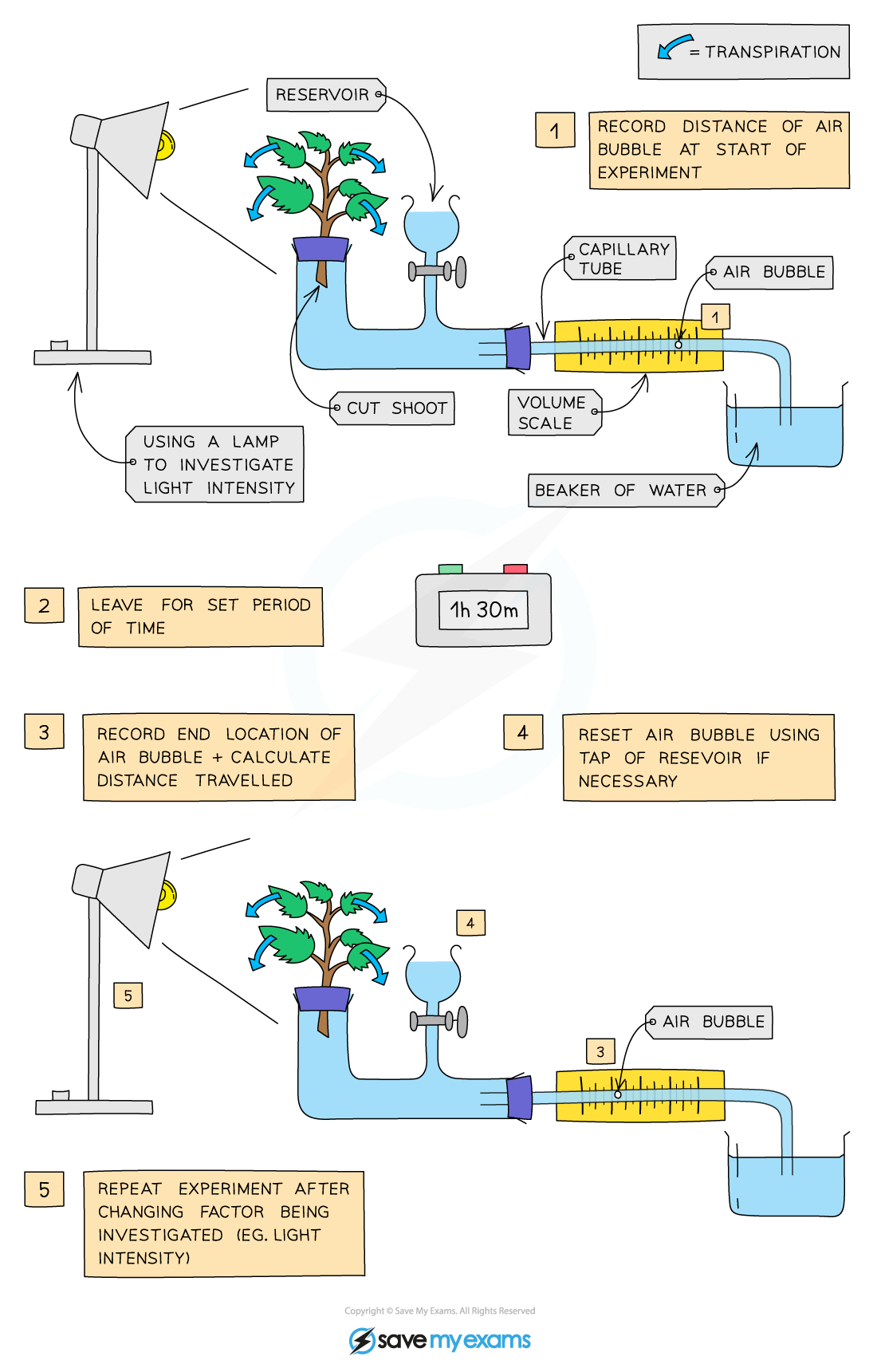Chapters

Transpiration
- The movement of water through the plant’s xylem tissue is mainly because of the evaporation of water vapours from the leaves and the cohesive and adhesive attributes shown by the water molecules.
- The driving force which allows the water movement from the soil to the atmosphere through the cells in the plant is the gradient in water potential. The water potential in the soil is higher than in the atmosphere, therefore the water moves from a region of a higher concentration, i.e. the soil to the region of lower concentration, i.e. the atmosphere.
- Plants absorb water constantly through their roots and lose the water through tiny pores stomata in the leaves.
- Approximately, 99% of the water absorbed by the plant is lost via evaporation from the stem of the plant and its leaves in a process of transpiration.
Hence, we can formally define transpiration as:
The loss of water vapors from a plant to its environment through diffusion is known as transpiration.
The transpiration stream is defined as:
Water movement from roots to the leaves is known as transpiration stream
In the next section of the article, we will discuss the advantages of transpiration.
Advantages of Transpiration
The advantages of transpiration are:
- It cools the plant by evaporating water from the plant’s leaves
- The transpiration stream helps in the uptake of mineral ions
- The turgor pressure of the cells offers support to the leaves and the stem of non-woody plants. It provides support by allowing an enhanced surface area of the leaf blade
In the next section, we will discuss the movement of water through leaves.
Water Movement Through Leaves
Some environmental factors such as low humidity and high temperatures create a water potential gradient between the air inside the leaves and the air outside. There is a higher water potential due to the air inside the leaves and lower water potential in the air outside. This water potential gradient results in the diffusion of water vapours out of the leaves via stomata. When water is lost by transpiration, the water potential in the air spaces that surrounds the mesophyll cells is lowered. The water inside the mesophyll cell walls evaporates into these air spaces which results in a transpiration pull.
The transpiration pull causes the movement of water through the mesophyll cell wall or out of the mesophyll cytoplasm. The water leaves the xylem vessels through pits because of the pull from the water movement through the mesophyll cells. It then results in the upward movement of water in the xylem vessels due to the cohesive and adhesive properties of water. This movement is referred to as a transpiration stream. When transpiration rates are high, the xylem walls are pulled inwards because of the fast-flowing water.
The Role of the Stomata in Transpiration
- The pairs of guard cells surround the stomata which control the transpiration
- When the guard cells are turgid, they open the stomata and when they lose water, they close the stomata
- The rate of transpiration and gaseous exchange is higher when the stomata are open
- The transpiration and gaseous exchange decline as the stomata are closed
- Because the stomata enable gaseous exchange, i.e., they let in carbon dioxide and let out oxygen, hence, they usually remain open during the day
In the next section of the article, we will discuss the factors that affect the rate of transpiration
Factors Affecting the Rate of Transpiration
Air movement, temperature, humidity, and light intensity are the factors that affect the rate of transpiration.
- The plants photosynthesize at a greater rate in the presence of more light. It means that with the increase in the intensity of light, the stomata open because more oxygen is needed. However, during this, more water evaporates, hence the rate of transpiration increases.
- If the environment is more humid, the water potential gradient between the inside and outside of plants is lower. Hence, there is less transpiration because diffusion gets slower.
- The evaporation rate increases with the increase in temperature. It means that the amount of water the outside air holds increases which further increases the water potential gradient. Hence, the transpiration rate also increases.
- The rate of transpiration is greater if more water is available. This is because more water is taken up by the roots.
Measuring Transpiration Through Potometer
A potometer is employed to investigate the impact of environmental factors on the transpiration rate. This apparatus makes a sealed environment with water which can be employed to measure the uptake of water based on how far an air-water meniscus move with time. The assembling of the potometer must be conducted underwater and it should be sealed with waterproof jelly such as Vaseline to keep it airtight. Any air that enters it breaks the cohesive forces of the transpiration stream and halts the transpiration pull.
Materials needed
The following materials are needed for this experiment:
- Plant shoot
- Capillary tube
- Scalpel/scissors
- Paper towels
- Cutting board
- Volume scale
- Beaker
- Vaseline
- Potometer
- Stopwatch
Procedure
- Cut the shoot underwater to stop the air from entering the xylem
- Put the shoot in the tube
- Set up the apparatus as shown in the diagram below:

- Ensure that the apparatus is airtight. Use Vaseline to seal the gaps. The readings will be affected if the air enters the apparatus.
- Dry the shoot’s leaves because any moisture on the leaves will affect the transpiration rate
- Remove the capillary tube from the water beaker to enable the creation of a single air bubble. Put the tube back into the water.
- Set up the environmental factor you want to investigate
- Let the plant to adapt the new environment for five minutes
- Record the initial location of the air bubble
- Leave for a definite period
- Record the endpoint of the bubble
- Keep changing the intensity of light, speed of the wind, or humidity or temperature level.
- Open the tap below the reservoir to reset the bubble
- Repeat the experiment
- The more the bubble moves at the same time, the faster is the rate of transpiration and vice versa.
We can investigate the environmental factors in the following ways:
- Airflow: Set up a hairdryer or a fan
- Humidity: Spray water in the bag made up of plastic and wrap it around the plant
- The intensity of light: Keep varying the distance of the light source from the plant
- The temperature of room: Room temperature (warm room or cold room)













Keep on teaching us,you are excellent teachers
This is great
Thanks a lot for this book,it really helped me a lot
It’s useful to me
Thanks a lot for your Better book!
It’s a perfect article, go ahead